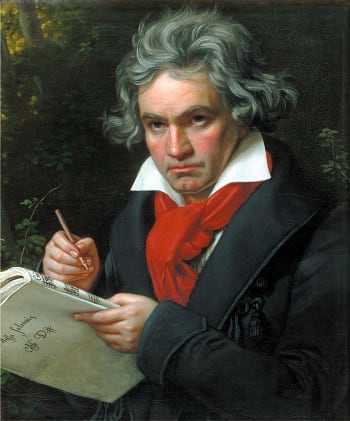Rundel Video: An die Freude - Ode to Joy | Media center
HomepageMedia centerRundel Video: An die Freude - Ode to Joy
This Media Center item can only be displayed if you agree to the use of marketing cookies. With one click you can accept it.
An die Freude - Ode to Joy
Info
Notes available at:
https://www.rundel.de/en/
Musik aus dem Finale der 9.Sinfonie, op.125 / Music from the finale of the 9th Symphony
Die Europahymne / The European Anthem
"An die Freude" can also be performed with band and choir. The additional chor parts are available separately.
Beethoven’s Symphony No. 9 is a grandiose work, in regard both to its musical substance, as well as because of the political declaration associated with this piece. The composer leaves as his legacy the sentence: “All men become brothers”. It is no wonder that Beethoven’s Symphony No. 9 has been laid claim to by all political systems imaginable and has accordingly been used for their purposes. Beethoven’s Ninth surpasses everything existent to that date in scope and complexity. It would definitely go beyond the scope of this preface to appraise the grand architecture of this work. People seriously interested in this aspect can study the copious specialized literature available. Parts of the music of Symphony No. 9 have long enjoyed a life of their own. The setting to music of Schiller’s “Ode to Joy” with its simple, catchy tunes is known by many people all over the world - even though they may know nothing or only a little of the “origin” of this song or of Beethoven’s last symphony. There is no doubt that declaring “Ode to Joy” the European anthem was a wise decision that certainly corresponds to Beethoven’s political ideals. The Finale of Symphony No. 9 could be described as a combination of the serial principle (variation) and development techniques. The second musical motif (“You millions, I embrace you”) that contrasts strongly with the well-known first theme, and the complex development sections were not considered for an adaptation to the wind band. The present arrangement consequently is restricted to parts, which the listener may easily associate with the main theme of the finale (namely the European anthem). This is a legitimate approach, as “Joy, bright spark of divinity” may well boast its own story of reception by now. Thus a little sequence of variations came into existence that is based on sections that all stem from Beethoven’s Finale. However, here they were arranged in a different way - as there was the restriction to the anthem-tune.
Grade Level GB: 6-7
Grade Level USA: 4 (Advanced)
Composer: Beethoven, Ludwig van
Arranger: Loritz, Albert
Genre: Concert Piece
Performance time: 5,45
Publisher: Rundel
Size: DIN A4
Info: Full Score + Parts
Rundel Order Number: MVSR2356
Release Date: 2006
https://www.rundel.de/en/
Musik aus dem Finale der 9.Sinfonie, op.125 / Music from the finale of the 9th Symphony
Die Europahymne / The European Anthem
"An die Freude" can also be performed with band and choir. The additional chor parts are available separately.
Beethoven’s Symphony No. 9 is a grandiose work, in regard both to its musical substance, as well as because of the political declaration associated with this piece. The composer leaves as his legacy the sentence: “All men become brothers”. It is no wonder that Beethoven’s Symphony No. 9 has been laid claim to by all political systems imaginable and has accordingly been used for their purposes. Beethoven’s Ninth surpasses everything existent to that date in scope and complexity. It would definitely go beyond the scope of this preface to appraise the grand architecture of this work. People seriously interested in this aspect can study the copious specialized literature available. Parts of the music of Symphony No. 9 have long enjoyed a life of their own. The setting to music of Schiller’s “Ode to Joy” with its simple, catchy tunes is known by many people all over the world - even though they may know nothing or only a little of the “origin” of this song or of Beethoven’s last symphony. There is no doubt that declaring “Ode to Joy” the European anthem was a wise decision that certainly corresponds to Beethoven’s political ideals. The Finale of Symphony No. 9 could be described as a combination of the serial principle (variation) and development techniques. The second musical motif (“You millions, I embrace you”) that contrasts strongly with the well-known first theme, and the complex development sections were not considered for an adaptation to the wind band. The present arrangement consequently is restricted to parts, which the listener may easily associate with the main theme of the finale (namely the European anthem). This is a legitimate approach, as “Joy, bright spark of divinity” may well boast its own story of reception by now. Thus a little sequence of variations came into existence that is based on sections that all stem from Beethoven’s Finale. However, here they were arranged in a different way - as there was the restriction to the anthem-tune.
Grade Level GB: 6-7
Grade Level USA: 4 (Advanced)
Composer: Beethoven, Ludwig van
Arranger: Loritz, Albert
Genre: Concert Piece
Performance time: 5,45
Publisher: Rundel
Size: DIN A4
Info: Full Score + Parts
Rundel Order Number: MVSR2356
Release Date: 2006
Recommended Articles
An die Freude
Ode to Joy
"An die Freude" can also be performed with band and choir. The additional chor parts are available separately.
Beethoven’s Symphony No. 9 is a grandiose work, in regard both to its...Concert Band
MVSR2356
Recommended Persons
Ludwig van Beethoven
* 17.12.1770† 26.03.1827
Ludwig van Beethoven was a German composer and pianist. He is counted among the most outstanding composers in music history. His father Johann van Beethoven recognized his son's extraordinary talent early on and ensured a solid musical education. Beethoven first performed publicly as a pianist at the age of seven. In 1782 his first piano compositions were published. In 1784 his teacher wrote...Info
Albert Loritz
* 13.11.1953† 15.12.2018
Albert Loritz was born in 1953 in Rot near Laupheim (today: Burgrieden) in the Upper Swabian region. In 1972 he graduated from high school in St. Wendel (Saarland). From 1972 to 1978 he studied at the music academy and university in Freiburg (Breisgau): School music with a major in organ, music theory, composition and musicology.
Albert Loritz was a music teacher in his main profession, at a...Info


